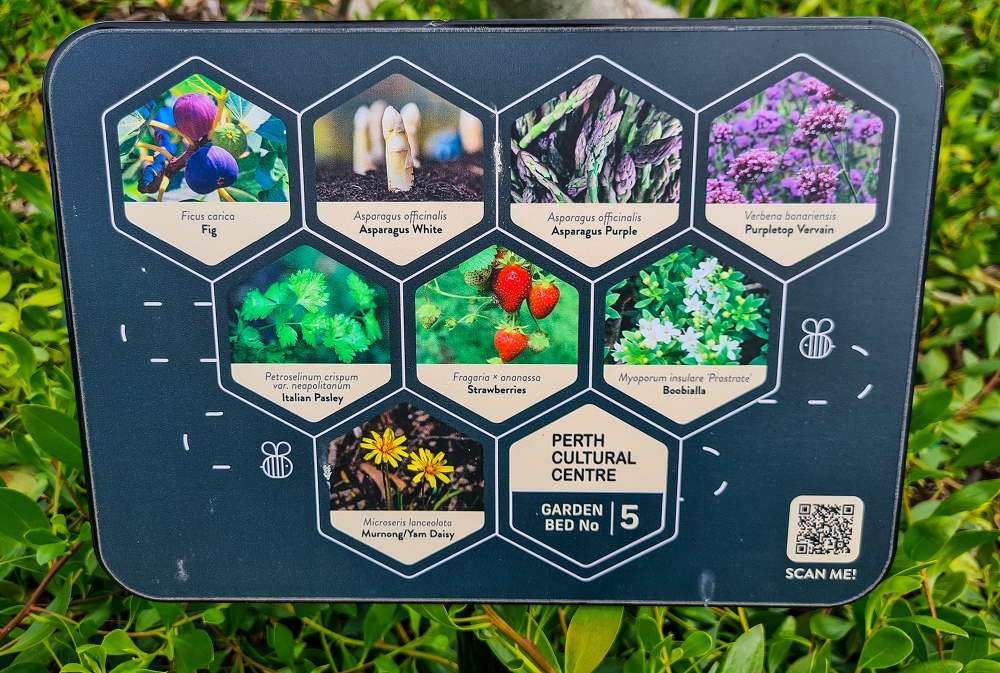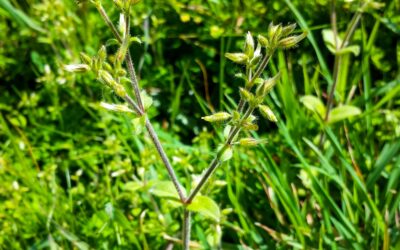Estimated reading time: 15 minutes
We’ve always been fans of growing plants under your fruit trees.
We’ve often found ourselves swimming against the tide of myths and practices encouraging weed-free ground under fruit trees.
We’re of the strong opinion that bare ground is never a good idea!
For a start, plants under fruit trees increase diversity in your garden and attract bees and other beneficial insects.
In the permaculture world planting a group of plants together is often called a ‘guild’. It’s also a key aspect of creating a food forest in your garden.
But deciding what to grow can be puzzling. There are just so many choices, how on earth are you meant to know what goes with what?
The diverse garden beds at Perth Cultural Centre
We were delighted to find these garden beds at the Urban Orchard during a visit to Perth. We’ve also written about them in this blog.
We think a public garden that is dedicated to showing people what to grow under their fruit trees is a brilliant idea!
It provides a space to actually test the theory of planting flowers, herbs, and vegetables under your fruit trees.
In most cases it has worked brilliantly. Not all the plants that are listed on the boards are evident in the beds, so there have apparently been some failures.
But as anyone who gardens understands, not everything you plant thrives! Plant death and failure are to be expected sometimes.
We’re grateful to Perth Cultural Centre for creating these stunning gardens so we can all learn from their experience. Plus, we all get to admire the beauty from afar!
In no particular order, here are a selection of the beds. We hope you find them as inspirational as we do.
Bed 5: Fig (var. unknown)

Plants growing under the fig tree:
- White asparagus (Asparagus officinalis)
- Purple asparagus (Asparagus officinalis)
- Purple vervain (Verbena bonariensis)
- Italian parsley (Petroselinum crispum var. neapolitanum)
- Strawberries (Fragaria x ananassa) – there are many different varieties of strawberry and they make a wonderful cover plant beneath fruit trees
- Boobialla (Myoporum insulare ‘Prostrate‘) – also known as common boobialla or native juniper, in the figworth family
- Murrnong (Microseris lanceolata) – also called Yam Daisy, an edible native tuber

Bed 6: Nectarine tree (var. unknown)


Plants growing under the tree in bed 6:
- Red Russian kale (Brassica oleracea) – a stunning purple kale
- Red chicory (Cichorium intybus)
- Eggplant (Solanum melongena)
- Genovese basil (Ocimum basilicum)
- Snapdragon (Antirrhinum majus)
- Dianthus (Dianthus caryophyllus) – also known as carnation
- Marigolds (Tagetes erecta) – a reliable and tough flowering plant that has been included in many of the beds in the Perth community garden. Has many medicinal properties.
- Amaranth (Amaranthus) – there are many different species of amaranth, but most have edible leaves and/or seeds

Bed 12: Josephine pear tree

Plants growing under the tree:
- Sunflowers (Helianthus)
- Rhubarb (Rheum rhubarbarum)
- Artichoke (Cynara scalymus)
- Fennel (Foeniculum vulgare)
- Tuscan kale (Brassica oleracea var. palmifolia)
- Rainbow chard (Beta vulgaris subsp. cicla var. Flavescens)
- Pumpkin (Cucurbita)
- Alyssum (Lobularia maritime)
- Dianthus (Dianthus caryophyllus)
- Marigold (Tagetes erecta)

Bed 13: Macadamia and mango trees


Plants growing under the trees:
- French lavender (Lavandula staechas)
- Citronella geranium (Pelargonium ‘Citronella‘)
- Comfrey (Symphytum)
- Tansy (Tanacetum vulgare)
- Feverfew (Tanacetum parthenium)
- Society garlic (Tulbaghia violacea)
- False valerian (Centranthus ruber)
- Yarrow (Achillea millefolium)
- Salt bush (Atriplex nummularia)

Bed 15: Guava and Meyer lemon trees

Understory plants:
- Elderflower or elderberry (Sambucus)
- Wormwood (Artemisia absinthium)
- Citronella geranium (Pelargonium ‘Citronella‘)
- French lavender (Lavandula staechas)
- Dill (Anethum graveolens)
- Comfrey (Symphytum)
- Tansy (Tanacetum vulgare)
- Purple vervain (Verbena bonariensis)
- Pineapple sage (Salvia elegans)
- Clary sage (Salvia sclarea)
- Catnip (Nepeta cataria)
- Yarrow (Achillea millefolium)
- Lemon balm (Melissa officinalis)

Garden Bed 17: Orange tree

Understory plants:
- Elderflower (Sambucus). Berries and flowers contain high levels of antioxidants and vitamins that can help with immune function. Used to treat inflammation, stress, gut problems, headaches, fever, kidney problems, and HIV/AIDS.
- Comfrey (Symphytum)
- Yarrow (Achillea millefolium). A useful plant for healing wounds, plus can be useful for stomach problems and anxiety.
- Tansy (Tanacetum vulgare)
- Society garlic (Tulbaghia violacea)
- Marjoram (Origanum majorana). Mainly known as a culinary herb. Marjoram can also be used to treat digestion and menstruation problems.
- Lemon balm (Melissa officinalis)
- Maroon bush (Scoevola spinascens). Also called Murin, this native plant has been used in traditional medicine for colds and stomach issues.

Number 18: Olive tree (Manzanillo)

Understory plants:
- Prostrate rosemary (Rosmarinus officinalis Prostatus)
- Chives (Allium schoenoprasum). Contain Vit K, C, and A. Potentially useful for treating cancer, sleep disorders, and inflammation.
- Oregano (Origanum vulgare)
- Mint (Mentha)
- It looks like there’s some calendula in there as well, even though it’s not on the board

Hopefully, your brain is pinging with new ideas about what to plant under your fruit trees.
Happy planting!
Related Articles
What’s the best way to control weeds under fruit trees?
Many gardeners hate weeds under their fruit trees. Managed correctly, they can bring many benefits to your trees and soil.
Do your fruit trees have the right pollination partners?
Estimated reading time: 6 minutes Pollination partners for fruit trees are one of those things that most gardeners have heard of, but few really…
Is organic growing really any better?
Long-term studies have shown that organic growing is better for your health and the planet, and it may even be better for your pocket.








Great post. I’ve been wanting to plant more beneath my trees, other than the weeds that have taken over what I planted last year. I noticed some plants are quite high around the tree. Is this a problem with insects?
Do the vegetables need looking after or can they be left to do their own thing? I’d prefer plants/vegetables that don’t need much attention and also perennial plants would be great. I have apple, pear, plum and peach trees, so are there any vegetables that shouldn’t be planted around these?
Do these under-fruit-tree plantings make it difficult to pick the fruit?
Great question Grace! In my garden, I use small stepping stones to make a path to the trees (usually at least two different access points), this also helps make it clear where to walk, avoid soil compaction & protect your understory plants. Meg – GGF team.
Hi Cheryl – great questions! In short, yes at certain times of year, plants really close the trunks of your fruit trees can help certain insects crawl upwards into your tree. However, some would argue that having a really nice diverse understory would counterbalance this risk because you should hopefully be attracting lots of beneficial predators to keep things in balance naturally. In the past, when I’ve planted vegetables under my fruit trees, I’ve definitely added some extra organic matter before planting, usually aiming for something with a little extra nitrogen like composted manure, as annual vegies have quite different nutritional needs to a fruit tree. So the vegies would need the same looking after as anywhere else in your vegie patch.
And no, there aren’t really any definite ‘no’ combinations (a bit different to companion planting) of vegie/herb & fruit trees. However, I reckon you’re on the right track with perennials or annual veg that you can just let self sow as understory plantings. Letting some flower will help bring in friendly insects & pollinators too. I love to use easy to propagate garden herbs like thyme, chives, lettuce, parsley, dill, sage, lemon balm. Bush beans and peas can be great. Creeping things like strawberries, warragul greens and nasturtiums. Bigger plants like pumpkins can also make a great fast ground cover for summer. So much to choose from! Meg – GGF team.
Hello, when spraying a cover spray like wettable sulphur on the trees, how does that affect the understorey planting? I have herbs planted under my trees but I never want to eat them because they are always covered in sulphur. How do you use an edible understorey with a cover spray?
After reading one of your articles about understory, I decided to plant white clover under my apple and pear trees. Initially it was great, but now seems to have rust all through it. Should I remove all of the understory, or spray it with something? Will this rust transfer to the trees?